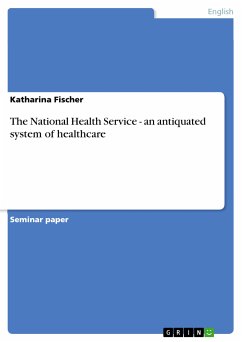
The National Health Service - an antiquated system of healthcare (eBook, ePUB)
Sofort per Download lieferbar
Statt: 15,95 €**
13,99 €
inkl. MwSt. und vom Verlag festgesetzt.
**Preis der gedruckten Ausgabe (Broschiertes Buch)
Alle Infos zum eBook verschenkenWeitere Ausgaben:

PAYBACK Punkte
0 °P sammeln!
Seminar paper from the year 2005 in the subject English Language and Literature Studies - Culture and Applied Geography, grade: 2,3, University of Kassel, course: Britain under New Labour, language: English, abstract: At the turn of the 21st century the British system of health care is to be found in serious difficulties. Expenditure constantly grows and the medical services are not able to meet the needs of the population. Patients have to set their names on waiting lists for hospital treatments, staff is underpaid and the top-down structure of the system antiquated and inefficient. In fact, ...
Seminar paper from the year 2005 in the subject English Language and Literature Studies - Culture and Applied Geography, grade: 2,3, University of Kassel, course: Britain under New Labour, language: English, abstract: At the turn of the 21st century the British system of health care is to be found in serious difficulties. Expenditure constantly grows and the medical services are not able to meet the needs of the population. Patients have to set their names on waiting lists for hospital treatments, staff is underpaid and the top-down structure of the system antiquated and inefficient. In fact, we are facing three major problems: Funding, social change and structure. Funding is almost entirely based on a tax model, combined with a certain demographic model. However during the past fifty years the population has changed, which led to a budget deficit and a dramatically worsening of the services. If there has been a high unemployment, the governmental tax income decreased. On the one hand, life expectancy increases and therefore the demand for medical support. On the other hand, the state is confronted with a declining birth-rate. Children represent the next generation of tax-payers and so the governmental tax income will decrease and the gap between financial resources and expenditure enlarges. The NHS was once founded after the Second World War as an institution of social security and justice to provide free health care for all. In former times, concerning medical supply, people were dependent on themselves, respectively on their financial status. The new model promised to be an advancement. Now the NHS is about to regress. Today, costs for certain medical services are transferred from state to citizens. The system is antiquated, a more flexible model is needed here, which resists major social changes and financial fluctuations. This implies a completely different model of funding and a structural modernisation. A general private insurance is only one alternative. An other opportunity would be the privatisation of the administrative and clinical sector.
Dieser Download kann aus rechtlichen Gründen nur mit Rechnungsadresse in A, B, BG, CY, CZ, D, DK, EW, E, FIN, F, GR, HR, H, IRL, I, LT, L, LR, M, NL, PL, P, R, S, SLO, SK ausgeliefert werden.













